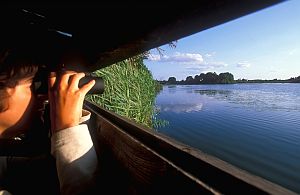News
SPIRAL "UK National Ecosystem Assessment" paper publshed
A new paper has been published based on work carried for SPIRAL, authored by Kerry Waylen and Juliette Young. This paper focuses on the first phase of the UK National Ecosystem Assessment.
Upcoming Event
No upcoming events.
Citizens encouraged to help monitor wild bird species

The public can help assess the human impact on wild birds through amateur 'citizen science' networks, according to new research. Scientists evaluated the suitability of data collected by amateur bird-watchers for long-term monitoring of European bird populations. Their findings suggest that citizen data may significantly improve the accuracy of existing official survey methods, as well as help increase public awareness of wild bird conservation.
Approximately 43 per cent of bird species in Europe are currently facing serious decline and wild populations have been protected under EU law since the late 1970s1. Birds are also thought to be good indicators of environmental change and scientists are keen to monitor small changes in population trends to monitor the impact of human-induced environmental changes, such as habitat loss and degradation.
Amateur bird spotting is potentially a very useful data source on wild populations, as part of citizen science networks, which collect data from amateurs for use in scientific programmes. However, the data can be difficult to interpret by scientists. The research, conducted in Sweden, quantified the reliability of such information by directly comparing data collected by members of the public between 2001 and 2009 with independent data from the official Swedish Bird Survey2 (SBS) for the same time period.
Scientists collected the public data from an internet database, known as the Species Gateway3 (SG), which stores details of over 19 million observations of birds from more than 9,500 amateur enthusiasts across Sweden. To correspond with the official SBS data, the researchers only considered observations from early May to early June, the time of year when most species breed (3.7 million observations).
When all 242 recorded species were looked at together, they found support for a positive relationship between the two datasets. However, the species subsets displayed variation from positive to negative correlations. According to the study, these differences may be caused by biases in the SG data compared to the standardised methods of the professional SBS. For example, bird-watchers are less likely to report the most common species and are more likely to visit particular sites where they know they will see a species of interest. Different observers will also have different abilities in spotting and identifying birds.
However, it is suggested that these drawbacks can be partially corrected for. The SG method may also be considerably better at monitoring less-common to rare species, which are often under-sampled by traditional survey techniques. Importantly, the scientists found that the similarity between the datasets was significantly greater for bird species that vary considerably in their population size from year to year (169 out of the total 242 species), as these fluctuations are likely to be well represented by both approaches.
This led the scientists to conclude that citizen-based data on wild bird populations can be considered reliable for specific purposes and should be used to complement existing monitoring techniques. Providing that the limitations of the data are fully understood and treated with care, they suggested that maintaining a healthy citizen science data network for use in future assessments of the state of wild bird populations could potentially lead to more targeted and efficient conservation efforts.
Source: Science for the Environment, May 20th 2011
1. EU Birds Directive 2009/147/EC
2. Swedish Bird Survey
3. Species Gateway
Source: Snäll, T., Kindvall, O., Nilsson, J., Pärt, T., (2011). Evaluating citizen-based presence data for bird monitoring. Biological Conservation. 144: 804-810.
Contact: tord.snall@slu.se




